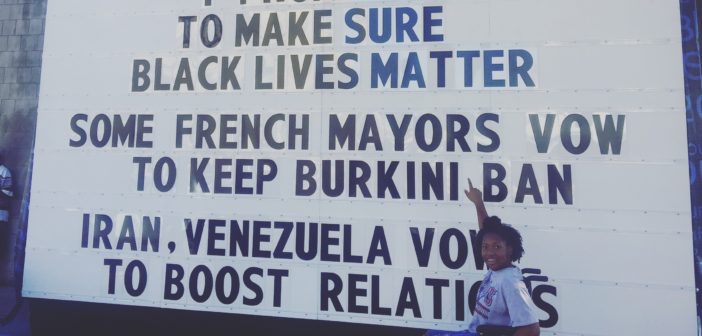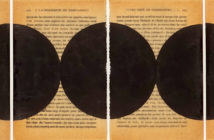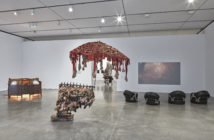“…the problem lies not whether to reach for either larger or more selective audiences, but rather in understanding for ourselves our own definitions of those groups we wish to speak to, and in making conscious steps to reach out to them in a constructive and methodical way”.
Through many experiences in the recent years, I have come to realize that our “self” is the construct of a vast collection of people and perspectives, which influence our thoughts and values. When we speak of to our self, it is an inward speech reflecting our society and civilization. With these beliefs in mind, I was honored to be part of Paul Ramirez Jonas’s Public Trust, a multi-layered, complex, interactive public artwork produced by Now and There. In this essay I explore the relationship between artist and public, class and culture, social practices and collaboration in various public spaces and reflect on my experience as a Public Trust performer in its sites, Dudley, Kendall, and Copley Squares.

Paul Ramirez Jonas's Public Trust in Copley Square.
In Mapping the Terrain, Suzanne Lacy writes about finding the good and redefining art not as primary product, but as process of finding value, a set of philosophies and making it happen as an ethical action. Class is a fundamental issue for art, and art cannot have a clear idea of its own nature if doesn’t have a clear idea of the interests of the different classes and surroundings. There was gratitude and respect in the engagements at all three of Public Trust’s sites; the work penetrated the critical discourse as we made a safe space for all who set out to make a promise of their choosing. What began as a practice to engage community about the value of our words became a trust exercise between strangers, an empowering dialogue. The performer rotations allowed each performer to reach beyond familiar social boundaries and into the larger community.

Paul Ramirez Jonas's Public Trust Boston in Dudley Square.
There were times in Dudley where people didn’t want us there; they didn’t perceive the project as “art.” In his book Ben Davis explains that understanding art means understanding class relations outside the sphere of visual art and how they affect that sphere as well, and that “the notion of an “art world” implies a sphere that is separate or set aside from the issues of the non “art world” (and so separates it from class issues outside that sphere.” On the second day in Dudley, we were visited by a young woman who asked us personal questions about our involvement to perhaps justify our presence. She was irritated--not happy with us--and clearly didn’t want us there. What I love about Ramirez Jonas’s work is that it’s accessible to everyone, and anyone can participate in being the artist. The woman’s iritation and questions were part of the project. Ramirez Jonas also hired performers from various origins: China, Mexico, Iraq, Iran, Albania, and Honduras.
Public Trust’s installation looks simple from afar, but viewed from different lenses of the media it definitely had a deeper impact on the performers and public who was engaging with us. This was especially the case in Dudley when a young man who’d go to sleep with the sun, not knowing he would even wake up to see it the next day, a woman who wouldn’t let anyone steal her sparkle and shine, a mother promising to stay clean to give her daughter a better future. We carried the stories and people close to our hearts; we could have stayed there for the whole length of the project.
In contrast, the interactions and promises in Kendall were much different. The promises made here were of self-growth, self-care/love, physical and mental growth, such as promising to be more thoughtful and less reactive, to be more open minded, to practice loving-kindness in tough situations, to remind herself that she would be okay, or to open a fried chicken and donut shop. Will Chambers, one of the performers, explained that sitting and giving his promise was “when the weight and true power of this experience hit me. A personal promise witnessed by the public is a heavy thing and also a gift.”
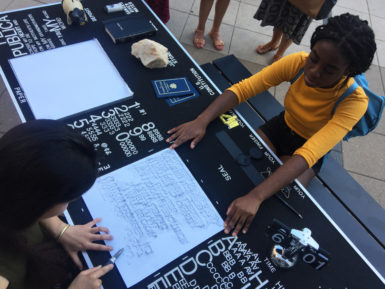
From Paul Ramirez Jonas's Public Trust.
In outlining the social structures and context in the art world, Pablo Helguera explains that “artists make art that creates an art world that makes all of us who belong to that world perform. And, as we perform, we contribute to the construction of an art scene. Also that contemporary art makes us perform self-conscious or interpretive acts, and the construction of value in the work is determined less by the object itself than by the nature or our interpretive performances.”
One of the heaviest moments was when a participant in Kendall promised not to take her life. My entire body and soul shook when she spoke to me. She cried and opened her arms to the sky as she made her oath. We embraced in tears and she went on with her day.
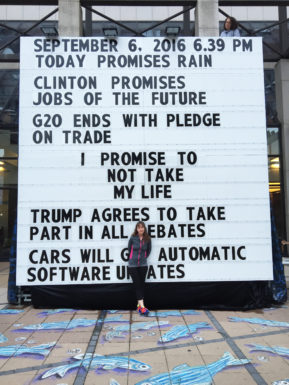
Paul Ramirez Jonas's Public Trust in Kendall Square.
One of the most infuriating moments was a woman who had shouted at us on 9/11 and returned to promise to vote for Trump. I was baffled, as an immigrant I was livid, but as a performer I had to stay calm. I wrote her promise on the big wall (blood boiling), and I took her picture. She told me we were crazy and walked off. Davis writes that creative expression “should not be thought of as a privilege but as a basic human need. Because creative expression is basic human need, it should be treated as a right to which everyone is entitled.”This wasn’t self-expression to me, and it felt like by not speaking up I was being a silent bystander. It was hard to not judge some of the promises made, and in our current political turmoil. However, since promises only got taken down when a new one was made, Ramirez Jonas was empowered at the sight of the Trump voter to make his: “I’ll try not to be a victim, perpetrator, or a bystander.”
A level of seriousness was very striking in the interaction; sharing a story with a stranger, and taking their own words earnestly was powerful. As they would sit, most participants, before articulating their actual promise, would discuss the depth of meaning behind it, and why it was important for them to be reminded of this promise. I met a peace activist, who worked with people in recovery after her brother passed of overdose and who helped with racial justice and refugee rights in the Middle East and Lebanon. Recently, she was in Greece, where she brought art supplies to the kids to help them in any way with the transition. She promised “to live with love, work for recovery, racial justice, & refuge rights."

From Paul Ramirez Jonas's Public Trust.
The aspiration of both the interactions and this project as a whole was to move beyond offering an aesthetic or intellectual experience, but in turn facilitate the creation of a temporary, but powerful, community-engaging work. With each location and new participants, the project offered a platform for dynamic participatory and social engaging space, as a result being a bridge or mediator between groups of people who don’t normally come in contact with one another.
“It is sufficient for art to reveal social conditions, rather than change them; and this reinforces a class division whereby the educated elite speak down to the less privileged.” On our last day in Kendall, an older Indian woman, Servanda, was having a difficult time expressing her promise because of its weight, so Graham Yeager was assisting. A Caucasian woman, impatiently waiting tried to cut her in line, saying she didn’t have time. The Indian woman, who, along with her daughters, had been sexually abused by men her entire life, promised to “help educate men in the value of women and children in India.” The other, impatient woman, who finally waited finally sat with me and promised: “Less email, more real life & conversation”. I only wondered why keeping her promise couldn’t have started with Servanda or this project, and if she realized the contradiction of her words and actions.
Sociologist Howard S. Becker, who wrote about the sociology of art and how art is formed through the coordination of many individuals, characterizes human behavior in relation to objects as the following: “Humans act towards things on the basis of the meaning as they ascribe to those things."
Our presence and work affected each community and in many ways it made me a better person. I am extremely grateful for all the people I came in contact with and the conversations they shared. I would like to end this essay with a poem by Eduardo Galeano; if we take responsibility for our actions, treat people with care and respect, we wouldn’t have to live with so much fear.
Fear
One morning they gave us a guinea pig.
It came to the house in a cage. At midday, I opened the door of the cage.
I returned home at nightfall and found the guinea pig just as I had left it:
inside the cage, huddled against the bars,
trembling with the fear of freedom.
References/Notes
TO BE IS TO BE PERCEIVED: In terms of idealist philosophy, esse est percipi (to be is to be perceived), pg. 19, Art Scenes, The Social Scripts of The Art World, 2012, Pablo Helguera
- Art Scenes, The Social Scripts of The Art World, 2012, Pablo Helguera
- Mapping the Terrain: New Genre Public Art, 1995, Suzanne Lacy
- Another Day, Another Hashtag. White People, You Gotta Get to Work NOW, Luvvie Ajayi
- Resonance and Wonder, Stephen Greenblatt
- 5. 9.5 Thesis on Art and Class, 2013, Ben Davis
- If You Vote for Trumpt, Then Screw You, By Drew Magary, a GQ correspondent and author.
- Artificial Hells, Participatory Art and The Politics of Spectatorship, 2012, Claire Bishop
Speaking of Oda Projesi (in Turkish meaning room project), a group of three artists whose work exemplifies a superior model of collaborative practice.
- Conversation Pieces, 2004, Grant Kester
- Art Worlds,1982, Howard S. Becker
- The Book of Embraces, 1989, Eduardo Galeano, Winner of the Lannan Prize for cultural freedom.
- For interviews with Paul Ramirez Jonas and other Public Trust performers, please visit Silver Projects.

